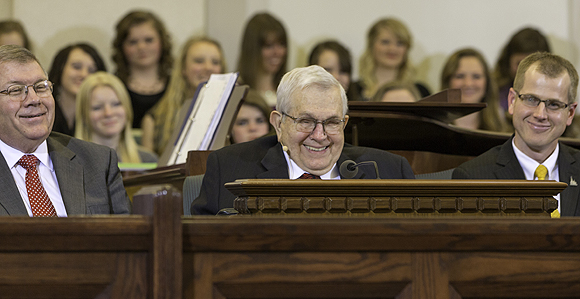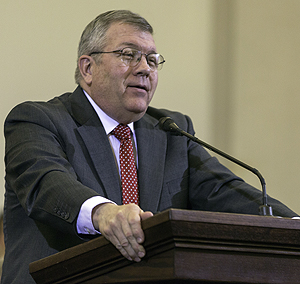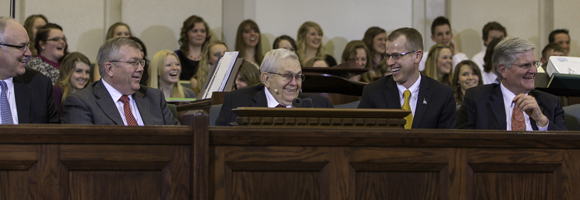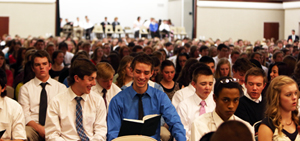President Packer Visits Brigham City for Seminary Centennial
Contributed By R. Scott Lloyd, Church News staff writer

President Boyd K. Packer enjoys a light moment during his address at the Brigham City seminary centennial devotional. At left is Elder Allan F. Packer of the Seventy and at right is President Aaron Shepherd of the Brigham City Utah South Stake, chairman of the Brigham City Seminary Board of Education.
BRIGHAM CITY, UTAH
Prior to speaking at a meeting commemorating 100 years of Church seminary in Brigham City, President Boyd K. Packer remarked to his son Elder Allan F. Packer that “he had traveled 2.5 million miles to be able to be back here tonight.” President Packer, President of the Quorum of the Twelve Apostles, and Elder Packer of the Seventy, eldest son of President Packer and Sister Donna S. Packer, are both natives of Brigham City, where President Packer as a young man was a seminary teacher.
Both spoke at the devotional Sunday evening, January 26, held in the Brigham City Utah West Stake Center and carried via Internet broadcast to meetinghouses in the seven stakes that have students attending the Brigham City seminary, including the nearby communities of Willard and Perry.
Two years ago, the Church marked 100 years since the seminary program originated adjacent to Salt Lake City’s Granite High School, but 2014 is the centennial of seminary in Brigham City, which now has the longest-running seminary operating in the Church.
The more than 2.5 million miles referred to the distance that President Packer has traveled since he left Brigham City, first as a bomber pilot in the military, later as supervisor and coordinator of seminaries throughout the Church, and ultimately as a General Authority, Elder Packer told the congregation, which consisted primarily of seminary students and some former seminary teachers.
“As a young man graduating from Box Elder High School just after the war started, he was pulled into World War II, as were most young men that age, and went off to boot camp and then training,” Elder Packer said.
“One night, in the middle of the night, as he was being shipped off to the South Pacific, he remembers riding the train through Brigham City. No one knew he was on the train. As he went past the station that we passed as we came in, he looked out, recognized the station manager, and thought about family that were sleeping at home as he headed north and eventually went into the Pacific.”

Elder Allan F. Packer of the Seventy addresses the Brigham City seminary centennial devotional prior to introducing his father, President Boyd K. Packer of the Quorum of the Twelve. Photo by Clinton Melander.
It was his first real trip away from the area, and he didn’t know if he would return, Elder Packer said.
But he did return, married his Brigham City bride Donna Smith, whom he had met at Weber College in nearby Ogden, and eventually gained a doctorate in education at Brigham Young University in Provo.
Not long after he returned from military service, his stake president encouraged him to apply for a vacancy on the Brigham City seminary faculty. He received the appointment, and that began his career in Church education.
Conducting the commemorative devotional, President Aaron Shepherd of the Brigham City Utah South Stake invited the congregation to view a historic photo projected on a screen of “the first-ever seminary Book of Mormon class taught in 1953, and you can see on the left President Packer as the instructor.”
President Shepherd explained that in those days, high school credit was given for seminary courses in the Old and New Testament, but it would not be offered for Book of Mormon courses. “President Packer organized, wrote the curriculum, and conducted the first-ever Book of Mormon course as a released-time, early-morning seminary class.”

President Boyd K. Packer enjoys a light moment during his address at the Brigham City seminary centennial devotional. At left is Elder Allan F. Packer and at right is President Aaron Shepherd of the Brigham City Utah South Stake, chairman of the Brigham City Seminary Board of Education.
Today, Book of Mormon courses are taught throughout the seminary system.
Keying on an account given in Elder Packer’s talk, President Packer spoke of his involvement in the beginning of the Intermountain Indian School in Brigham City.
The school was housed on the campus of the former Bushnell Hospital constructed on the south end of town and operated by the U.S. Army to care for wounded soldiers.
With the ending of World War II, the hospital was closed. Local and state leaders proposed that it be used as a U.S. government boarding school for high school-age students from Indian tribes primarily in southern Utah and northern Arizona.

First seminary Book of Mormon class, held in 1953 at the Brigham City seminary, shows a young Boyd K. Packer at left as the instructor. Photo courtesy of President Boyd K. Packer.
At a meeting of community leaders held in the Brigham City Tabernacle to discuss the matter, Church President George Albert Smith arrived, traveling from Salt Lake City contrary to his doctor’s advice because he saw the importance of the topic.
President Smith told meeting attendees: “When the suggestion was first made that an Indian school be established in one of our Latter-day Saint communities, I wrote the president of the United States, Harry S. Truman, and urged him to use his influence and administrative power to consummate this action. In this way the American people would redeem themselves from some of the injustices that had been heaped upon the heads of the American Indians during the history of our country.”
President Smith promised Brigham City residents that anything they did to help the Indian people would be answered with a blessing upon their heads.
As a member of the committee involved in establishing the school, President Packer was deeply involved in the process.
“The citizens said, ‘Yes, we ought to welcome the Indian people here.’ My mind had already been solidified when President George Albert Smith came into the tabernacle.”
In a reflective mood, President Packer told the seminary centennial congregation, “I regret, in a way, that this meeting is not held in the old tabernacle. I love that building, but I cannot get up the steps anymore.”

The Brigham City Utah West Stake Center’s chapel is filled with students attending the devotional commemorating the 100th anniversary of Brigham City’s seminary program on Sunday, January 26, 2014. Photo by Laura Seitz, Deseret News.
He said it is an incredible thing that the city block on which the new Brigham City Utah Temple was built was available when it came time to build the temple. It is located across the street to the west of the tabernacle.
“They had built two schools on it and then closed them both. Then, when the time came for a temple to be built, there it was. And as we came in from the south, there it is: the temple, the Brigham City Temple.”
He said the temple is a great responsibility for the community as well as a blessing. “A temple changes a community, and it is changing Brigham City and will forever,” he said.
Noting that he was born and reared in Brigham City in a family of 11 children, he said, “At one time, there were six of the boys and three of the sons-in-law in the military somewhere in the world.”
Though the war ended, in a sense, it isn’t over, he mused. “The conditions that led up to it have been gradually circling around. If you have vision to see, you can see that the adversary is working to destroy the people, the Latter-day Saints, the Americans. If we do not take hold of it and learn the gospel and live the gospel, the adversary could win. He will not win. He can’t! But he will not because we will do the things that we should do, which are simple, and that is to live the gospel.”
President Packer reminisced about gaining a testimony of the gospel while serving in the military. It happened, he said, on the island of le Shima, off the northwest coast of Okinawa.
While the island was under siege, a makeshift structure had been erected of 50-gallon gas tanks filled with sand. An opening had been left where one of the barrels was missing.
“I crawled in there without a testimony, determined I needed one, and asked the Lord about it,” he recalled. “I came out of there knowing. That has been my life and my desire, to have a wife and family that would support the desire to measure everything by the gospel of Jesus Christ.”
He said that as he had come into Brigham City that evening he thought, “Well, this is perfect, the perfect place.
“It is a perfect place and will remain that way so long and so far as we as Latter-day Saints live the gospel.
“The town has not changed. There are just more of you here and just as good as they were then and not as good as they are going to be, because we have a ministry to perform. Here ‘in the shadows of these everlasting hills,’ as the expression goes, there is no better place on earth to live, to raise a family. There is no better place to seek a testimony and to live it and express it around the world.”
President Packer told of visiting a seminary on an Indian reservation in South Dakota in a little home with a dirt floor.
“There was a circle in the living room, as it were, of little Indian youngsters sitting around Sister Two Dogs. Sister Two Dogs was the teacher. She was teaching them the gospel of Jesus Christ. I have not forgotten her and what she was doing.”
President Packer said he was emotionally touched by coming back to Brigham City.
“It was just six months short of 90 years ago that I was born here,” he said. “I do not feel like I am 90, but I am going to reach that in six months and still have a lot to do. I cannot walk because of polio, but that is incidental. I can think, and I can speak.”
He said Brigham City is special and spoke of having been on nearby Willard Peak. “You get up there, and you look around and see the marvelous things that you behold in these valleys. It took a lot of power of the pioneers to get it all put together and to bring it here.”
Saying he was in a pensive mood, President Packer asked the student scheduled to give the closing prayer if she would mind if he gave it in her place.
In the prayer, he invoked an apostolic blessing upon the people attending the meeting that from time to time they will feel the strength that has come to them from the efforts and turmoil that went into building the city and building the Church.
Music for the program was provided by a choir of Brigham City seminary students and faculty.
A video presentation was shown, put together by Brigham City seminary students and faculty celebrating the history of seminary in the Church and in Brigham City.
